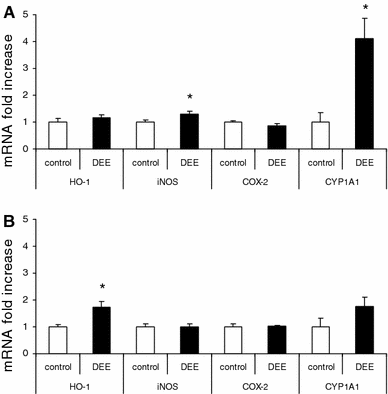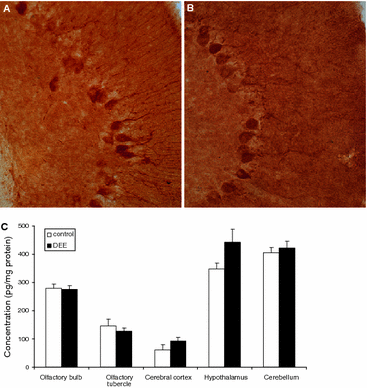Comparative evaluation of the effects of short-term inhalation exposure to diesel engine exhaust on rat lung and brain
- PMID: 20467864
- PMCID: PMC2886900
- DOI: 10.1007/s00204-010-0551-7
Comparative evaluation of the effects of short-term inhalation exposure to diesel engine exhaust on rat lung and brain
Abstract
Combustion-derived nanoparticles, such as diesel engine exhaust particles, have been implicated in the adverse health effects of particulate air pollution. Recent studies suggest that inhaled nanoparticles may also reach and/or affect the brain. The aim of our study was to comparatively evaluate the effects of short-term diesel engine exhaust (DEE) inhalation exposure on rat brain and lung. After 4 or 18 h recovery from a 2 h nose-only exposure to DEE (1.9 mg/m(3)), the mRNA expressions of heme oxygenase-1 (HO-1), inducible nitric oxide synthase (iNOS), cyclooxygenase-2 (COX-2), and cytochrome P450 1A1 (CYP1A1) were investigated in lung as well as in pituitary gland, hypothalamus, olfactory bulb, olfactory tubercles, cerebral cortex, and cerebellum. HO-1 protein expression in brain was investigated by immunohistochemistry and ELISA. In the lung, 4 h post-exposure, CYP1A1 and iNOS mRNA levels were increased, while 18 h post-exposure HO-1 was increased. In the pituitary at 4 h post-exposure, both CYP1A1 and HO-1 were increased; HO-1 was also elevated in the olfactory tuberculum at this time point. At 18 h post-exposure, increased expression of HO-1 and COX-2 was observed in cerebral cortex and cerebellum, respectively. Induction of HO-1 protein was not observed after DEE exposure. Bronchoalveolar lavage analysis of inflammatory cell influx, TNF-alpha, and IL-6 indicated that the mRNA expression changes occurred in the absence of lung inflammation. Our study shows that a single, short-term inhalation exposure to DEE triggers region-specific gene expression changes in rat brain to an extent comparable to those observed in the lung.
Figures




References
-
- Abbas I, Saint-Georges F, Billet S, Verdin A, Mulliez P, Shirali P, Garcon G. Air pollution particulate matter (PM2.5)-induced gene expression of volatile organic compound and/or polycyclic aromatic hydrocarbon-metabolizing enzymes in an in vitro coculture lung model. Toxicol In Vitro. 2009;23:37–46. doi: 10.1016/j.tiv.2008.09.020. - DOI - PubMed
-
- Abraham NG, Drummond GS, Lutton JD, Kappas A. The biological significance and physiological role of heme oxygenase. Cell Physiol Biochem. 1996;6:129–168. doi: 10.1159/000154819. - DOI
-
- Bidmon HJ, Emde B, Oermann E, Kubitz R, Witte OW, Zilles K. Heme oxygenase-1 (HSP-32) and heme oxygenase-2 induction in neurons and glial cells of cerebral regions and its relation to iron accumulation after focal cortical photothrombosis. Exp Neurol. 2001;168:1–22. doi: 10.1006/exnr.2000.7456. - DOI - PubMed
-
- Block ML, Wu X, Pei Z, Li G, Wang T, Qin L, Wilson B, Yang J, Hong JS, Veronesi B. Nanometer size diesel exhaust particles are selectively toxic to dopaminergic neurons: the role of microglia, phagocytosis, and NADPH oxidase. Faseb J. 2004;18:1618–1620. - PubMed
Publication types
MeSH terms
Substances
LinkOut - more resources
Full Text Sources
Research Materials

